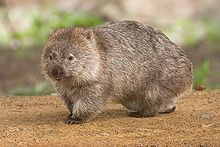- Common wombat
-
common wombat[1] 
Conservation status Scientific classification Kingdom: Animalia Phylum: Chordata Class: Mammalia Infraclass: Marsupialia Order: Diprotodontia Family: Vombatidae Genus: Vombatus
É. Geoffroy, 1803Species: V. ursinus Binomial name Vombatus ursinus
(Shaw, 1800)
Common Wombat range The common wombat (Vombatus ursinus), also known as the coarse-haired wombat or bare-nosed wombat, is a marsupial, one of three species of wombats and the only one in the genus Vombatus. The common wombat grows to an average of 98 cm (39 in) long and a weight of 26 kg (57 lb).
Contents
Taxonomy
The common wombat was first described by George Shaw in 1800. There are three subspecies:
- V. ursinus hirsutus, the nominate form, is found on the Australian Mainland.[3]
- V. ursinus tasmaniensis, is found in Tasmania.[3] It is smaller in size than V. ursinus hirsutus. [4]
- V. ursinus ursinus, was once found throughout the Bass Strait Islands but is now restricted to Flinders Island to the north of Tasmania.[3] Its population was estimated at 4,000 in 1996 and is listed as vulnerable by the Environment Protection and Biodiversity Conservation Act 1999 and IUCN Red List.[5][6]
Distribution
It is widespread in the cooler and better watered parts of southern and eastern Australia, including Tasmania, and in mountain districts as far north as the south of Queensland, but is declining in Western Victoria and South Australia.
Description
Common wombats are sturdy and built close to the ground. When fully grown they can reach anywhere between 80 and 130cm, and between 17 and 40kg. The wombats found on Tasmania and Flinders Island are often smaller than their mainland counterparts. It is distinguished from both Hairy-nosed wombats by the fact that it has a bald nose.
Behaviour
Common wombats are a solitary, territorial species, with each wombat having an established range in which it lives and feeds. In this area, they dig a tunnel system, with tunnels ranging anywhere from 2 to 20 metres in length, along with many sidetunnels. There is usually only one entrance to the burrow, although they may create a smaller one to escape with. Often nocturnal, the common wombat does come out during the day in cooler weather, such as in early morning or late afternoon.[7]
Diet
Common wombats are herbivorous, subsisting off grass and other plant materials. Foraging is usually done during the night.[7]
Breeding
The common wombat can breed every two years and produce a single joey. The gestation period is about 20-30 days, and the young remain in the pouch for 5 months. When born, they weigh between 3.5 and 6.5 kg (7.7 and 14 lb). The joey is weaned at around 12 to 15 months of age and is usually independent at 18 months of age.[7].
References
- ^ Groves, C. (2005). Wilson, D. E., & Reeder, D. M, eds. ed. Mammal Species of the World (3rd ed.). Baltimore: Johns Hopkins University Press. pp. 43-44. OCLC 62265494. ISBN 0-801-88221-4. http://www.bucknell.edu/msw3.
- ^ Taggart, D., Martin, R. & Menkhorst, P. (2008). Vombatus ursinus. In: IUCN 2008. IUCN Red List of Threatened Species. Downloaded on 28 December 2008. Database entry includes justification for why this species is of least concern
- ^ a b c "Common Wombat". Department of Primary Industries, Parks, Water and Environment. http://www.dpiw.tas.gov.au/inter-nsf/WebPages/BHAN-53F7KJ?open. Retrieved 13 December 2009.
- ^ "Common Wombat". Wombania's Wombat Information Center. http://www.wombania.com/wombats/common-wombat.htm. Retrieved 13 December 2009.
- ^ Vombatus ursinus ursinus — Common Wombat (Bass Strait)
- ^ Australasian Marsupial & Monotreme Specialist Group (1996). Vombatus ursinus ssp. ursinus. 2006. IUCN Red List of Threatened Species. IUCN 2006. www.iucnredlist.org. Retrieved on 15 March 2007.
- ^ a b c "Wombats, Wombat Pictures, Wombat Facts". National Geographic Society. http://animals.nationalgeographic.com/animals/mammals/wombat/. Retrieved 21 July 2011.
External links
Categories:- IUCN Red List least concern species
- Mammals of Tasmania
- Vombatiforms
- Mammals of South Australia
- Mammals of New South Wales
- Mammals of Victoria (Australia)
- Marsupials of Australia
- Megafauna of Australia
- Monotypic mammal genera
- Animals described in 1800
Wikimedia Foundation. 2010.



